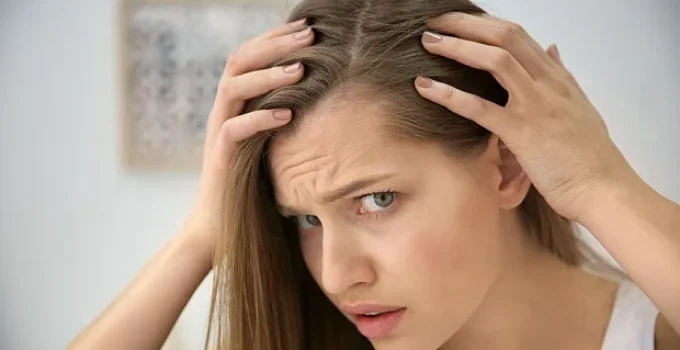Why Does Hair Fall Out?
It’s normal to see a few hairs in your brush or on your pillow—but have you ever wondered why hair falls out in the first place? Hair loss is a natural part of how your body works. Even though it may seem strange, losing hair is actually a sign that your body is healthy and your hair is going through its proper life cycle.
Let’s explore the science behind why hair falls out, how it grows, and what this means for our understanding of human anatomy.
🔎Dive Deeper
- What Is Hair Made Of?
- How Does Hair Grow?
- Why Does Hair Fall Out Naturally?
- How Much Hair Do We Lose Each Day?
- What Makes Hair Fall Out Faster?
- 🎯Final Thoughts
- 📚 References
What Is Hair Made Of?
Hair is made mostly of keratin, a strong protein that also makes up your fingernails and the outer layer of your skin. Each strand of hair grows out of a small pocket in the skin called a hair follicle. The root of the hair, which is under the skin, is the living part. The part you see above the skin is actually made of dead cells, which is why it doesn’t hurt when you cut your hair.
🧪 Interesting Fact: Keratin is so strong that some animals (like rhinos) have horns made entirely of it!
How Does Hair Grow?
Hair grows in three main phases:
| Phase Name | What Happens | Length of Time |
|---|---|---|
| Anagen Phase | Hair grows actively from the root | 2–7 years |
| Catagen Phase | Hair stops growing (transition phase) | About 10 days |
| Telogen Phase | Hair rests and then falls out | 3–4 months |
Once the telogen phase ends, a new hair begins growing in the follicle, pushing out the old one. This cycle continues for most of your life.
📊 Statistic: At any given time, about 85–90% of the hairs on your head are in the growing (anagen) phase
Why Does Hair Fall Out Naturally?
Hair falls out naturally during the telogen phase. This is completely normal. When a hair finishes its life cycle, it simply lets go and falls out so a new one can begin growing in its place.
The body is constantly replacing old cells—including skin and hair—with new ones. So, losing hair is a healthy part of how your body stays refreshed and renewed.
💡 Did You Know? According to the National Library of Medicine’s StatPearls, your body has about 5 million hair follicles, with around 100,000 on your scalp alone.
How Much Hair Do We Lose Each Day?
On average, a person loses 50 to 100 hairs per day. You may notice more in the shower, in your brush, or on your clothes, but this is totally normal.
Hair might fall out more easily when:
- You brush or style it
- You wash it
- It’s been pulled tight (like in a ponytail)
What Makes Hair Fall Out Faster?
While most hair loss is natural, some things can speed it up:
- Poor nutrition (like not enough protein or iron)
- Hormonal changes (like during puberty)
- Genetics (traits passed down from parents)
- Stress or injury (physical or emotional)
- Certain medications (like chemotherapy)
But remember, many of these are temporary. Hair usually grows back once the body is balanced again.
📝 Research Fact: According to a study published in the journal Clinical, Cosmetic, and Investigational Dermatology, the proportion of hair follicles in the growth stage decline with age.
🎯Final Thoughts
So, why does hair fall out? Hair falls out because it’s part of a natural cycle: grow, rest, and shed. This process helps keep your hair healthy by making room for new growth. It might seem scary to lose hair, but it’s actually a sign that your body is working the way it should. Unless there’s an unusual amount of loss, you have nothing to worry about—your follicles are simply doing their job!
📚 References
📚Murphrey MB, Agarwal S, Zito PM. Anatomy, Hair. [Updated 2023 Aug 14]. In: StatPearls [Internet]. Treasure Island (FL): StatPearls Publishing; 2025 Jan-. Available from: https://www.ncbi.nlm.nih.gov/books/NBK513312/
📚F. Costa, R. Silva, A.R. Boccaccini. “7 – Fibrous protein-based biomaterials (silk, keratin, elastin, and resilin proteins) for tissue regeneration and repair.” Editor(s): Mário A. Barbosa, M. Cristina L. Martins, Peptides and Proteins as Biomaterials for Tissue Regeneration and Repair Woodhead Publishing, 2018, Pages 175-204, ISBN 9780081008034, doi.org/10.1016/B978-0-08-100803-4.00007-3.
📚Hoover, Ezra. National Library of Medicine. StatPearls. “Physiology, Hair.” https://www.ncbi.nlm.nih.gov/books/NBK499948/
📚Burg, Dominic et al. “Promotion of anagen, increased hair density and reduction of hair fall in a clinical setting following identification of FGF5-inhibiting compounds via a novel 2-stage process.” Clinical, cosmetic and investigational dermatology vol. 10 71-85. 27 Feb. 2017, doi:10.2147/CCID.S123401
📌Learn More About Human Hair
- What Is the Rarest Hair Color✂A Look at the World’s Uncommon Locks
- What Causes Gray Hair✂The Science Behind Silver Strands
- Why Do People Have Different Hair Colors✂The Genetics Behind Every Shade
- What Causes Hair to Stand Up (Goosebumps!) ✂The Body’s Chilly Reflex Explained
- What Is Human Hair Made Of✂The Surprising Science Behind Every Strand What Are Hair Follicles✂Tiny Structures with a Big Job
